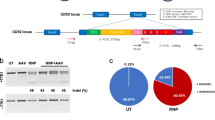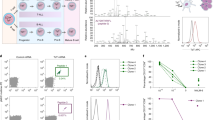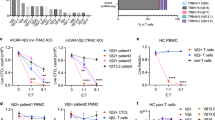Abstract
In adoptive T-cell transfer as an intervention for malignant diseases, retroviral transfer of T-cell receptor (TCR) genes derived from CD8+ cytotoxic T-lymphocyte (CTL) clones provides an opportunity to generate a large number of T cells with the same antigen specificity. We cloned the TCR-αβ genes from a human leukocyte antigen (HLA)-A*2402-restricted CTL clone specific for MAGE-A4143–151. The TCR-αβ genes were transduced to 99.2% of non-TCR expressing SupT1, a human T-cell line, and to 12.7–32.6% of polyclonally activated CD8+ T cells by retroviral transduction. As expected, TCR-αβ gene-modified CD8+ T cells showed cytotoxic activity and interferon-γ production in response to peptide-loaded T2-A*2402 and tumor cell lines expressing both MAGE-A4 and HLA-A*2402. A total of 24 clones were established from TCR-αβ gene-transduced peripheral blood mononuclear cells and all clones were functional on a transduced TCR-dependent manner. Four clones were kept in culture over 6 months for analyses in detail. The transduced TCR-αβ genes were stably maintained phenotypically, functionally and genetically. Our results indicate that TCR-transduced αβ T cells by retroviral transduction represent an efficient and promising strategy for adoptive T-cell transfer for long term.
This is a preview of subscription content, access via your institution
Access options
Subscribe to this journal
Receive 12 print issues and online access
$259.00 per year
only $21.58 per issue
Buy this article
- Purchase on Springer Link
- Instant access to full article PDF
Prices may be subject to local taxes which are calculated during checkout


Similar content being viewed by others
Abbreviations
- CTL:
-
cytotoxic T lymphocyte
- EBV-B cells:
-
Epstein–Barr virus-transformed B cells
- ELISA:
-
enzyme-linked immunosorbent assay
- ELISPOT assay:
-
enzyme-linked immunospot assay
- GM-CSF:
-
granulocyte macrophage colony-stimulating factor
- HLA:
-
human leukocyte antigen
- IFN:
-
interferon
- IL:
-
interleukin
- LTR:
-
long terminal repeat
- MSCV:
-
murine stem cell virus
- PBLs:
-
peripheral blood lymphocytes
- PBMCs:
-
peripheral blood mononuclear cells
- PGK:
-
phosphoglycerate kinase
- TCR:
-
T-cell receptors
- TNF:
-
tumor necrosis factor.
References
Gnjatic S, Nishikawa H, Jungbluth AA, Gure AO, Ritter G, Jager E et al. NY-ESO-1: review of an immunogenic tumor antigen. Adv Cancer Res 2006; 95: 1–30.
Boon T, Coulie PG, Van den Eynde BJ, van der Bruggen P . Human T cell responses against melanoma. Annu Rev Immunol 2006; 24: 175–208.
Rosenberg SA . Progress in human tumour immunology and immunotherapy. Nature 2001; 411: 380–384.
Morgan RA, Dudley ME, Wunderlich JR, Hughes MS, Yang JC, Sherry RM et al. Cancer regression in patients after transfer of genetically engineered lymphocytes. Science 2006; 314: 126–129.
Dudley ME, Wunderlich JR, Robbins PF, Yang JC, Hwu P, Schwartzentruber DJ et al. Cancer regression and autoimmunity in patients after clonal repopulation with antitumor lymphocytes. Science 2002; 298: 850–854.
Rosenberg SA, Yang JC, Restifo NP . Cancer immunotherapy: moving beyond current vaccines. Nat Med 2004; 10: 909–915.
Gattinoni L, Powell Jr DJ, Rosenberg SA, Restifo NP . Adoptive immunotherapy for cancer: building on success. Nat Rev Immunol 2006; 6: 383–393.
Schaft N, Willemsen RA, de Vries J, Lankiewicz B, Essers BW, Gratama JW et al. Peptide fine specificity of anti-glycoprotein 100 CTL is preserved following transfer of engineered TCR αβ genes into primary human T lymphocytes. J Immunol 2003; 170: 2186–2194.
Zhao Y, Zheng Z, Robbins PF, Khong HT, Rosenberg SA, Morgan RA . Primary human lymphocytes transduced with NY-ESO-1 antigen-specific TCR genes recognize and kill diverse human tumor cell lines. J Immunol 2005; 174: 4415–4423.
De Plaen E, De Backer O, Arnaud D, Bonjean B, Chomez P, Martelange V et al. A new family of mouse genes homologous to the human MAGE genes. Genomics 1999; 55: 176–184.
Duffour MT, Chaux P, Lurquin C, Cornelis G, Boon T, van der Bruggen P . A MAGE-A4 peptide presented by HLA-A2 is recognized by cytolytic T lymphocytes. Eur J Immunol 1999; 29: 3329–3337.
Miyahara Y, Naota H, Wang L, Hiasa A, Goto M, Watanabe M et al. Determination of cellularly processed HLA-A2402-restricted novel CTL epitopes derived from two cancer germ line genes, MAGE-A4 and SAGE. Clin Cancer Res 2005; 11: 5581–5589.
Smith SD, Shatsky M, Cohen PS, Warnke R, Link MP, Glader BE . Monoclonal antibody and enzymatic profiles of human malignant T-lymphoid cells and derived cell lines. Cancer Res 1984; 44: 5657–5660.
Tsuji T, Yasukawa M, Matsuzaki J, Ohkuri T, Chamoto K, Wakita D et al. Generation of tumor-specific, HLA class I-restricted human Th1 and Tc1 cells by cell engineering with tumor peptide-specific T-cell receptor genes. Blood 2005; 106: 470–476.
Heemskerk MH, Hagedoorn RS, van der Hoorn MA, van der Veken LT, Hoogeboom M, Kester MG et al. Efficiency of T-cell receptor expression in dual-specific T cells is controlled by the intrinsic qualities of the TCR chains within the TCR-CD3 complex. Blood 2007; 109: 235–243.
Le Gal FA, Ayyoub M, Dutoit V, Widmer V, Jager E, Cerottini JC et al. Distinct structural TCR repertoires in naturally occurring versus vaccine-induced CD8+ T-cell responses to the tumor-specific antigen NY-ESO-1. J Immunother 2005; 28: 252–257.
Nishikawa H, Qian F, Tsuji T, Ritter G, Old LJ, Gnjatic S et al. Influence of CD4+CD25+ regulatory T cells on low/high-avidity CD4+ T cells following peptide vaccination. J Immunol 2006; 176: 6340–6346.
Nishikawa H, Sato E, Briones G, Chen LM, Matsuo M, Nagata Y et al. In vivo antigen delivery by a Salmonella typhimurium type III secretion system for therapeutic cancer vaccines. J Clin Invest 2006; 116: 1946–1954.
Nagata Y, Furugen R, Hiasa A, Ikeda H, Ohta N, Furukawa K et al. Peptides derived from a wild-type murine proto-oncogene c-erbB-2/HER2/neu can induce CTL and tumor suppression in syngeneic hosts. J Immunol 1997; 159: 1336–1343.
Ikuta Y, Okugawa T, Furugen R, Nagata Y, Takahashi Y, Wang L et al. A HER2/NEU-derived peptide, a Kd-restricted murine tumor rejection antigen, induces HER2-specific HLA-A2402-restricted CD8+ cytotoxic T lymphocytes. Int J Cancer 2000; 87: 553–558.
Acknowledgements
We thank C Hyuga, S Hori and J Suzuki for their excellent technical support. This study was supported by a grant-in-aid for Scientific Research on Priority Areas from the Ministry of Education, Culture, Sports, Science and Technology of Japan.
Author information
Authors and Affiliations
Corresponding author
Additional information
Supplementary Information accompanies the paper on Gene Therapy website (http://www.nature.com/gt)
Supplementary information
Rights and permissions
About this article
Cite this article
Hiasa, A., Hirayama, M., Nishikawa, H. et al. Long-term phenotypic, functional and genetic stability of cancer-specific T-cell receptor (TCR) αβ genes transduced to CD8+ T cells. Gene Ther 15, 695–699 (2008). https://doi.org/10.1038/sj.gt.3303099
Received:
Revised:
Accepted:
Published:
Issue Date:
DOI: https://doi.org/10.1038/sj.gt.3303099
Keywords
This article is cited by
-
Potential of human γδ T cells for immunotherapy of osteosarcoma
Molecular Biology Reports (2013)
-
A Promising Vector for TCR Gene Therapy: Differential Effect of siRNA, 2A Peptide, and Disulfide Bond on the Introduced TCR Expression
Molecular Therapy - Nucleic Acids (2012)
-
siRNA-mediated silencing of PD-1 ligands enhances tumor-specific human T-cell effector functions
Gene Therapy (2012)
-
Rapid αβ TCR-mediated responses in γδ T cells transduced with cancer-specific TCR genes
Gene Therapy (2009)



